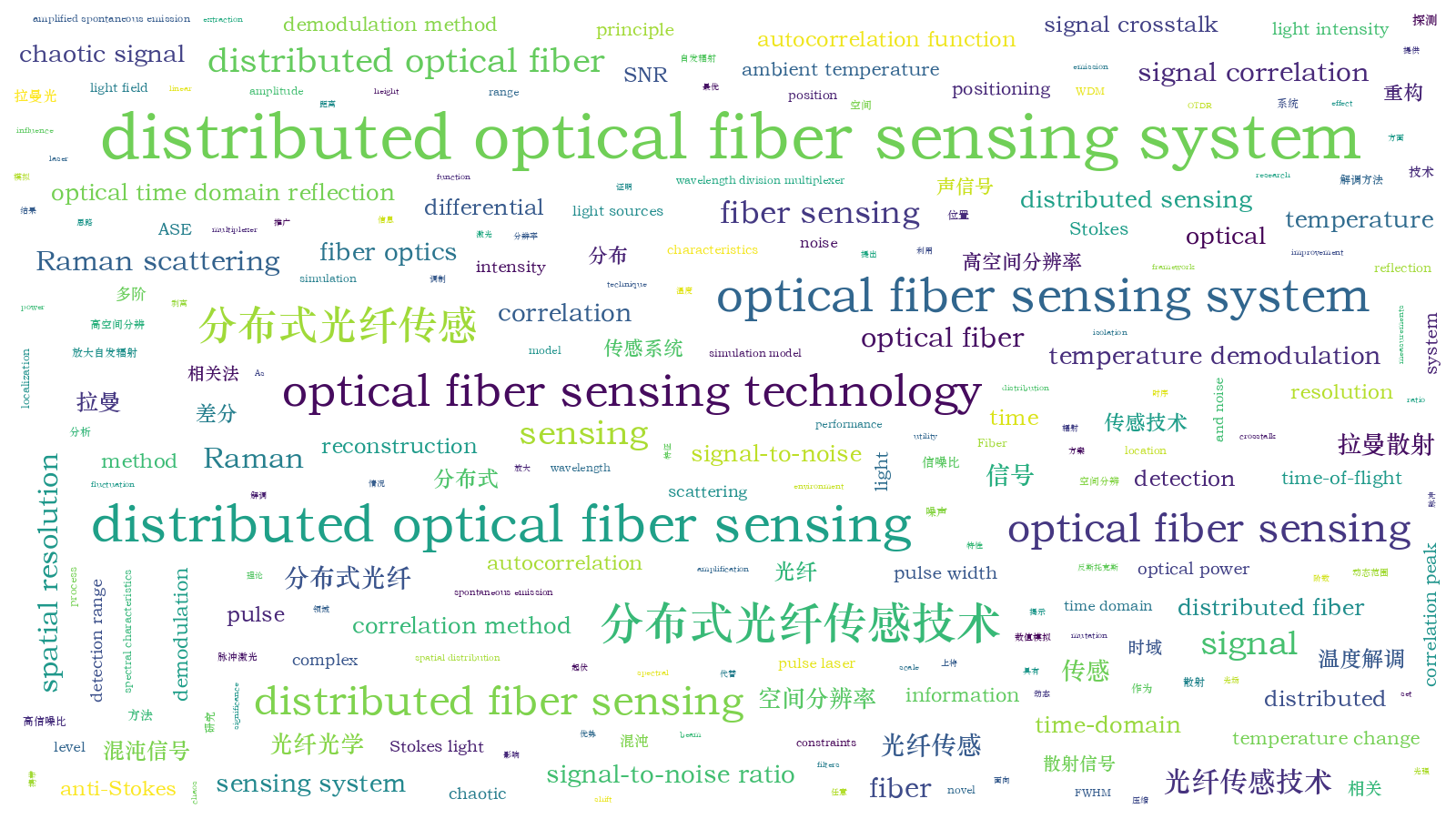多阶时域差分重构相关法拉曼分布式光纤传感
Raman distributed optical fiber sensing technology has scientific significance across various fields due to its unique ability to perform distributed measurements of spatial ambient temperature fields. However, the spatial resolution of existing Raman distributed optical fiber sensing with a detection range extending to kilometers is constrained to the meter level due to the physical limitations of the optical time domain reflection positioning principle, which relies on the pulse time-of-flight method. Therefore, we introduce an innovative Raman distributed optical fiber sensing approach based on a multi-order time-domain differential reconstruction correlation method. In this novel method, we replace the conventional pulse laser with chaotic, amplified spontaneous emission (ASE), and noise signals as the sensing sources, and then employ a multi-order time-domain differential reconstruction technique to reconstruct the Raman anti-Stokes scattering signal. This reconstruction process enables us to extract intensity information from each sensing fiber position point and thus capture the random fluctuation characteristics of detection signal timings. To further optimize the proposed approach, we employ a correlation compression demodulation method to unveil the correlation between the spatial position of the Raman scattering temperature-modulated light and the detection signal. Notably, our scheme diverges from the traditional optical time-domain reflection positioning principle, opting instead for the correlation positioning principle. This shift allows us to overcome the physical constraints associated with the pulse width of conventional light sources, thereby elevating the spatial resolution of the sensing technology from the traditional meter-scale performance to the centimeter level.
The simulation model adopts intricate pulse signals as the detection signals, including chaotic pulse signals, noise pulse signals, and ASE pulse signals. This model bifurcates into two beams using a haloscope, with one beam serving as the reference signal and the other functioning as the detection signal, and subsequently they enter the sensing fiber via a wavelength division multiplexer (WDM). During experimentation, a small segment of the sensing fiber experiences ambient temperature changes, designated as the detection fiber (FUT), while the remaining portion is still in a constant temperature environment. A WDM filters out Raman anti-Stokes scattering signals at 1450 nm wavelength. Subsequently, the Raman anti-Stokes scattered signal undergoes multi-order time-domain differential reconstruction followed by correlation with the reference signal, which facilitates the demodulation of temperature change information within the detection fiber. In the initial multi-order time-domain differential reconstruction, the Raman anti-Stokes scattered signal excited within the sensing fiber is subjected to the process. Based on the random amplitude characteristics of the complex signal timing, this procedure allows for the isolation of the Raman anti-Stokes signal from each data point location on the sensing fiber. Consequently, each data point of the reconstructed signal exclusively contains the scattered signal intensity information of an individual location point, as opposed to encompassing the light intensity information of all signals within the length corresponding to the pulse width in the OTDR positioning principle under the traditional scheme. Finally, the system employs relevant compression demodulation technologies, enabling the compression of scattering intensity information from all data points within FUT to the FUT's start and end positions. The precise compression facilitates the accurate determination of detailed FUT positions.
The chaotic signal exhibits a higher incoming fiber optical power and more significant random amplitude fluctuations, facilitating the extraction of Raman anti-Stokes light intensity at various fiber points by multi-order time-domain differential reconstruction. This contributes to an enhanced signal-to-noise ratio (SNR) within the Raman distributed sensing system, grounded in a complex signal correlation method (Fig. 2). All three signal sensing schemes adeptly pinpoint the FUT's position and length information. Notably, at temperature mutation points within the FUT region, we observe a pair of positively and negatively correlated peaks. Remarkably, the SNR of the chaotic signal-based sensing scheme surpasses that of both the ASE signal sensing scheme and noise signal sensing scheme (Fig. 4). The spatial resolution of the Raman distributed optical fiber sensing system is predicated on complex signal correlation hinges on the half-height full width (FWHM) of the autocorrelation function of the sensing detection signal. Our analysis of the autocorrelation results and spectral characteristics of three complex signal timings reveals that the employed FWHM of the three complex signal autocorrelation functions is 0.01 ns. Consequently, the theoretical spatial resolution is 1 mm (Fig. 5). We also observe a positive correlation between the differential order and the peak-to-peak value of positive correlation, which signifies a substantial improvement in the system's SNR within a certain range of increasing order. The optimal SNR for the chaotic sensing scheme occurs when the differential reconstruction order is set to the 5, surpassing the peak coefficient of 5.04 dB observed in the first-order case (Fig. 6). Furthermore, we find that the FUT's positively correlated peak-to-peak values demonstrate linear correlation with temperature (0.323 for every 1 K temperature increase in the above-mentioned simulation conditions). The correlation highlights the utility of positively correlated peaks for precise temperature change demodulation. We successfully achieve accurate demodulation of spatial localization and temperature for FUTs with 353 K and 373 K, featuring two 0.05 m lengths and 0.05 m intervals (Fig. 7).
We present a novel Raman distributed fiber sensing technology, which utilizes the multi-order time-domain differential reconstruction correlation method to enhance the spatial resolution and SNR performance in traditional Raman distributed optical fiber sensing systems. Furthermore, the correlation compression demodulation method is adopted to elucidate the spatial distribution of the Raman scattering temperature-modulated light field. Significantly, our approach supersedes the conventional optical time-domain reflection localization principle by adopting the correlation positioning principle, thus overcoming the spatial resolution constraints imposed by the pulse width of traditional light sources. As a result, the traditional meter-level sensing spatial resolution is theoretically elevated to the centimeter level. Meanwhile, we extend the theoretical framework of the differential reconstruction scheme to encompass any order and scrutinize the influence of differential order on the sensing system's SNR. Numerical simulations demonstrate that our method can extract more temperature information, encompassing the detection fiber region without compromising the sensing spatial resolution. Furthermore, it amplifies the SNR of the sensing signal by multiplying the scattered signal correlation peak's amplification effect. Additionally, it reduces the temperature signal crosstalk in the non-detection optical fiber region during the demodulation, enhancing the SNR of the Raman distributed optical fiber sensing system. Finally, we demonstrate the significant advantages of chaos signals in Raman sensing and introduce a fresh research perspective for Raman distributed optical fiber sensing technology.
李健, 范卜文, 程姿嘉, 薛晓辉, 张明江. 多阶时域差分重构相关法拉曼分布式光纤传感[J]. 光学学报, 2024, 44(1): 0106025. Jian Li, Bowen Fan, Zijia Cheng, Xiaohui Xue, Mingjiang Zhang. Raman Distributed Optical Fiber Sensing Based on Multi-Order Time-Domain Differential Reconstruction Correlation[J]. Acta Optica Sinica, 2024, 44(1): 0106025.







